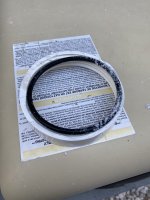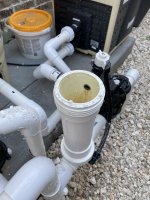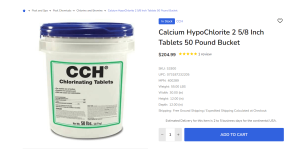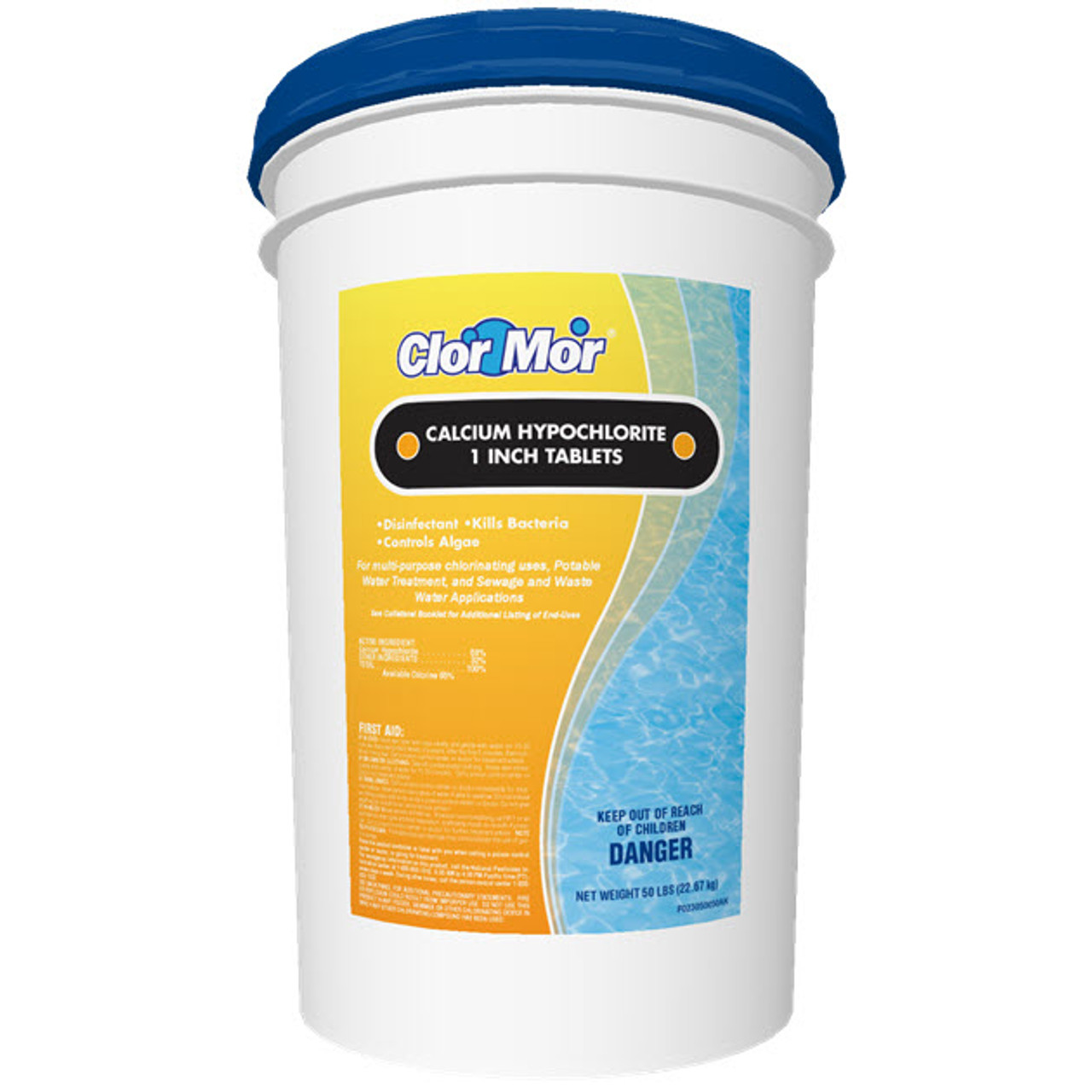Hi there. Tonight after putting in chlorine, the cap to our Chlorinator (pentair) blew off. Sounded like a bomb went off, and just blew the cap apart. The top flew up and over into the next door neighbor’s backyard. We bled the line as we always do when we turned it back on. Any thoughts on the cause and how to avoid this happening again?
Chlorinator cap exploded
- Thread starter Txtwnmomma
- Start date
You are using an out of date browser. It may not display this or other websites correctly.
You should upgrade or use an alternative browser.
You should upgrade or use an alternative browser.
- Jun 22, 2014
- 48,150
- Pool Size
- 17888
- Surface
- Fiberglass
- Chlorine
- Salt Water Generator
- SWG Type
- CircuPool RJ-45 Plus
Welcome to TFP!  When you say "after putting in chlorine", what do you mean? Did you add tablets to that tower, or did you pour something in there?
When you say "after putting in chlorine", what do you mean? Did you add tablets to that tower, or did you pour something in there?
 When you say "after putting in chlorine", what do you mean? Did you add tablets to that tower, or did you pour something in there?
When you say "after putting in chlorine", what do you mean? Did you add tablets to that tower, or did you pour something in there?- Jun 22, 2014
- 48,150
- Pool Size
- 17888
- Surface
- Fiberglass
- Chlorine
- Salt Water Generator
- SWG Type
- CircuPool RJ-45 Plus
Any chance you mixed the type of tabs? Cal-hypo versus trichlor-stabilized tablets? If you're not sure, maybe you can show some pics of the packaging.
- Jun 22, 2014
- 48,150
- Pool Size
- 17888
- Surface
- Fiberglass
- Chlorine
- Salt Water Generator
- SWG Type
- CircuPool RJ-45 Plus
If no one mixed the type of tablets or added any other chemical to the tower, any chance someone forgot to open a valve after the chlorinator causing a pressure build-up?
- Jun 24, 2021
- 7,809
- Pool Size
- 30000
- Surface
- Vinyl
- Chlorine
- Salt Water Generator
- SWG Type
- CircuPool RJ-60
The pressure would have been no higher that the water pressure, no? I vote for your first thought.If no one mixed the type of tablets or added any other chemical to the tower, any chance someone forgot to open a valve after the chlorinator causing a pressure build-up?
- May 23, 2015
- 24,542
- Pool Size
- 16000
- Surface
- Plaster
- Chlorine
- Salt Water Generator
- SWG Type
- Pentair Intellichlor IC-60
What’s in that chemical bucket with the orange lid? I’d bet it’s calcium hypochlorite.
If you like your heater, get rid of that chlorinator. Eventually it will cause heater damage. I've seen it happen in 6 months. Those were designed for commercial-pool use where the pump runs, at times, 24/7.
Cal hypo is one of the scariest chemicals in use for pools. It is an incredibly strong oxidizer. I know guys who lost the scoop that would come with a bucket and use a cup that had Coke residue. It can catch fire. It was very popular in Southern California several years ago. It used to come packaged in fiber barrels and there were many stories of pool techs driving the freeway with their barrel on fire because of something like that.What’s in that chemical bucket with the orange lid? I’d bet it’s calcium hypochlorite.
The combination of cal hypo and trichlor creates nitrogen trichloride.
One of the first documented explosions of nitrogen trichloride was in 1811 when Pierre Louis Dulong, lost three fingers and an eye due to an explosion of nitrogen trichloride.
In 1813, a nitrogen trichloride explosion blinded Sir Humphry Davy temporarily.
Michael Faraday and Sir Humphry Davy were both injured in another nitrogen trichloride explosion shortly thereafter.
Here is cal hypo with brake fluid.
One of the first documented explosions of nitrogen trichloride was in 1811 when Pierre Louis Dulong, lost three fingers and an eye due to an explosion of nitrogen trichloride.
In 1813, a nitrogen trichloride explosion blinded Sir Humphry Davy temporarily.
Michael Faraday and Sir Humphry Davy were both injured in another nitrogen trichloride explosion shortly thereafter.
Here is cal hypo with brake fluid.
- May 23, 2015
- 24,542
- Pool Size
- 16000
- Surface
- Plaster
- Chlorine
- Salt Water Generator
- SWG Type
- Pentair Intellichlor IC-60
Cal hypo was also known as “bleaching powder” and was a very common household laundry room chemical up until the 1960’s. Liquid bleach was too expensive and heavy to keep around and, as we all know, didn’t last very long. It wasn’t until Clorox really perfected the method of making liquid chlorine and heavily marketing it to homemakers that it surpassed cal hypo. Typical household bleaching powder was under 50% cal hypo.
If you mix a solution of cal hypo in a bucket with sodium carbonate in the right proportions and you let it settle out out (calcium carbonate precipitation), you can make a very strong mixture of sodium hypochlorite that has very little calcium in solution. I don’t suggest doing it though because the concentration of hypochlorite is typically very high and it will fume chlorine gas ….
If you mix a solution of cal hypo in a bucket with sodium carbonate in the right proportions and you let it settle out out (calcium carbonate precipitation), you can make a very strong mixture of sodium hypochlorite that has very little calcium in solution. I don’t suggest doing it though because the concentration of hypochlorite is typically very high and it will fume chlorine gas ….
After talking with my husband, it appears that is what he did. I am usually the one that does it and I always just use the tablets. Apparently last night he put the tablets in and some of the powder chlorine from that bucket back there.
- Jun 22, 2014
- 48,150
- Pool Size
- 17888
- Surface
- Fiberglass
- Chlorine
- Salt Water Generator
- SWG Type
- CircuPool RJ-45 Plus
That's what we figured. We see it here from time to time.After talking with my husband, it appears that is what he did.
 But thank goodness no one was nearby. As you can see, mixing some chemicals is extremely dangerous. But stick around and let us help you understand how to manage your pool. All you need is a proper test kit and some basic knowledge like the link below.
But thank goodness no one was nearby. As you can see, mixing some chemicals is extremely dangerous. But stick around and let us help you understand how to manage your pool. All you need is a proper test kit and some basic knowledge like the link below.By the way, not sure what type of equipment you have since your signature is not updated. But if you have a sand or DE filter with a mulitport valve, you can run it on recirculate to keep water moving. Stop using any tabs and just use liquid chlorine. Less side effects anyway.
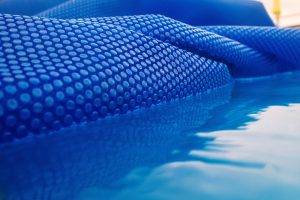
Pool Care Basics Archives
Your one-stop shop for all things TFP to include: ABCs of Water Chemistry, Recommended Chemicals/Levels, Test Kits, Troubleshooting, and much more!
I would estimate the primary reaction as below.
3Ca(OCl)2 + C3Cl3N3O3 --> 3NCl3 + 3CaCO3
Calcium hypochlorite + trichlor --> nitrogen trichloride (aka trichloramine) + calcium carbonate.
The explosion happens when the chlorine oxidizes the nitrogen, which releases a lot of energy.
The explosion reaction produces nitrogen gas and chlorine gas.
2NCl3 --> N2 + 3Cl2

3Ca(OCl)2 + C3Cl3N3O3 --> 3NCl3 + 3CaCO3
Calcium hypochlorite + trichlor --> nitrogen trichloride (aka trichloramine) + calcium carbonate.
The explosion happens when the chlorine oxidizes the nitrogen, which releases a lot of energy.
The explosion reaction produces nitrogen gas and chlorine gas.
2NCl3 --> N2 + 3Cl2
P
poolmagazine
That mistake you only make one time. Really glad nobody was hurt.After talking with my husband, it appears that is what he did. I am usually the one that does it and I always just use the tablets. Apparently last night he put the tablets in and some of the powder chlorine from that bucket back there.
SumOfOneInteger
Bronze Supporter
I know I'm very late to this party, but I want to make a Public Service Announcement.
DO NOT SWITCH BUCKET LIDS on your chemicals. OP has a bucket, presumably of Cal-Hypo, but with a yellow lid. Yellow lids are used on soda ash, sodium bicarb, and DRY ACID. Cal-Hypo has a red lid. Trichlor & Dichlor use navy blue lids. CYA, alum, etc. use a light blue lid.
Chemical lids will absolutely have residuals on them and using a dry acid lid on a cal-hypo tub is very dangerous. If you lose a lid to your new bucket o'chems and happen to have a lid from an empty container, just because the lid fits doesn't mean it should sits.
DO NOT SWITCH BUCKET LIDS on your chemicals. OP has a bucket, presumably of Cal-Hypo, but with a yellow lid. Yellow lids are used on soda ash, sodium bicarb, and DRY ACID. Cal-Hypo has a red lid. Trichlor & Dichlor use navy blue lids. CYA, alum, etc. use a light blue lid.
Chemical lids will absolutely have residuals on them and using a dry acid lid on a cal-hypo tub is very dangerous. If you lose a lid to your new bucket o'chems and happen to have a lid from an empty container, just because the lid fits doesn't mean it should sits.
I know I'm very late to this party, but I want to make a Public Service Announcement.
DO NOT SWITCH BUCKET LIDS on your chemicals. OP has a bucket, presumably of Cal-Hypo, but with a yellow lid. Yellow lids are used on soda ash, sodium bicarb, and DRY ACID. Cal-Hypo has a red lid. Trichlor & Dichlor use navy blue lids. CYA, alum, etc. use a light blue lid.
Chemical lids will absolutely have residuals on them and using a dry acid lid on a cal-hypo tub is very dangerous. If you lose a lid to your new bucket o'chems and happen to have a lid from an empty container, just because the lid fits doesn't mean it should sits.
Thread Status
Hello , This thread has been inactive for over 60 days. New postings here are unlikely to be seen or responded to by other members. For better visibility, consider Starting A New Thread.


